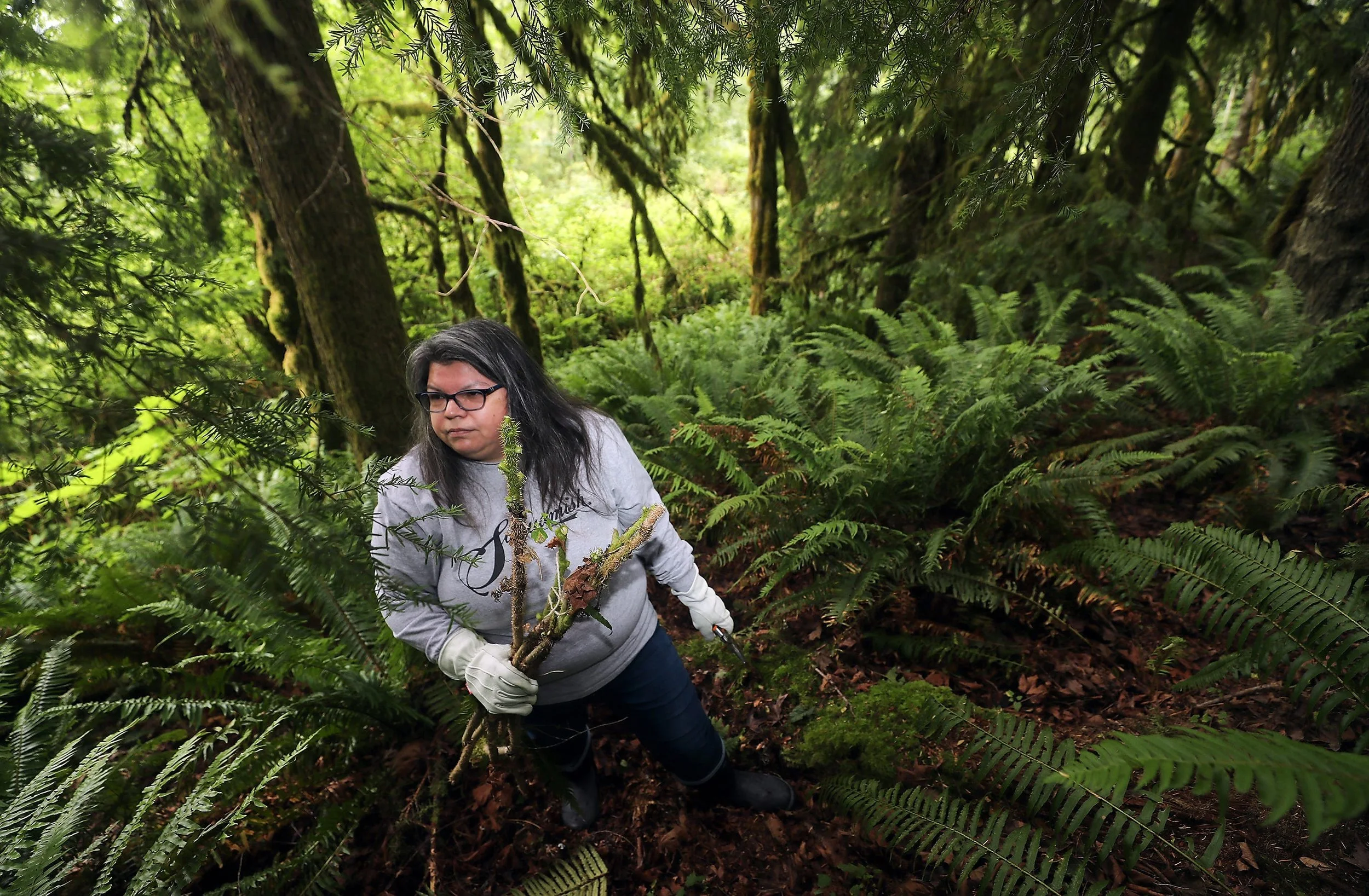nourishing traditions
Azure Bouré is part of a food sovereignty movement among Northwest tribes
Words by Alorie Gilbert
Photo: Meegan M. Reid-Kitsap Sun-USA TODAY NETWORK
As a child, Azure Bouré loved to catch tree frogs at recess and sneak buckets of garter snakes into her basement (to her mother’s chagrin). Her interest in “all thing wild” now fuels Bouré’s work as coordinator of the Traditional Foods and Medicine Program for the Suquamish Tribe. The program is part of a growing food sovereignty movement among Pacific Northwest tribes. Her mission is to return traditional plants and medicines to the daily lives of her people—from Suquamish Tribal Elders to middle and high school students at Chief Kitsap Academy to other local tribes starting similar programs. We’re honored to share her insights, along with one of her favorite recipes for spring.
The most rewarding part of leading my Tribe’s traditional food and medicine program is: seeing tribal members take the information I share and do the work on their own, like gathering nettles and making elderberry syrup or salves.
The program came about: in 2009 with diabetes prevention classes through the Suquamish Tribe’s Community Health Program. There were four classes the first year and so much interest from the community that more classes were added. The Tribal Council decided that this was something worth teaching, so the program expanded under the direction of Julia Bennett-Gladstone, the Tribe’s former Traditional Plants Educator. Julia brought me into the program as an apprentice 10 years ago, and it’s now a year-round program.
The impact I wish to make on my community is: to connect our community with our traditional foods and the bounty that we are blessed with here in our ancestral territory. Our community has been going through a cultural resurgence for several years. We have taken back our songs, our language and our cultural arts. Are we truly a sovereign nation if we cannot feed ourselves?
The impact of the modern American diet on the health and wellbeing of our tribe has been: nothing short of catastrophic. The variety of foods our ancestors ate was vast compared to our modern diet. We are eating significantly less variety but also the nutritional value has gone down over the last 50 years in the foods that we are eating. The people of Suquamish were known to travel great distances to gather their foods and were experts in preserving those foods to last all year long. Today we shop maybe every week or two.
The plant or medicine of greatest cultural significance to our tribe is: the Western Red Cedar. Cedar carries us in so many ways, providing us with tools, canoes, baskets and is central to our spirituality and ceremonies. Cedar has been one plant that we have not lost our connection with over the decades.
One thing people are surprised to learn from me is: that stinging nettles are not only edible but also delicious and highly nutritious. I have a whole class dedicated to cooking with nettle and harvesting without getting stung.
What I enjoy most about working with youth and teens is: watching youth who are unsure about the plant or food we are working with be brave enough to try it. The best reaction is when their faces light up.
I was born and raised in: Bremerton, Washington. I moved to the Port Madison Reservation in 1989 at age 16.
I welcome the arrival of spring by: walking all my favorite gathering areas to see how all my plant friends did over the winter. This gives me the fresh air and the exercise I need after being indoors all winter and also gives me a mental health boost. I love talking to the plants and thanking them for returning.
What keeps me busy outside my official duties is: research, hands down. I consider myself a perpetual student. I watch other herbalists gather and process their plants and foods. I participate in a global food justice group called Slow Foods Turtle Island and have traveled to Japan, Italy and Denver to learn from and share my experiences.
evergreen tree tip tea
Douglas fir, hemlock and spruce tips all have a lemony flavor, are high in Vitamin C and electrolytes, and are sometimes called Nature’s Gatorade.Harvesting tips
Harvest young tips when they are limey green and tender, usually April-June. They can be eaten straight as a trail snack, put into salads, or made into tea. Tips can be preserved in the fridge for several days or in the freezer for several months. You can also dry them in a basket or a food dehydrator.
Sun tea
Add a large handful of evergreen tree tips per quart of water to a glass container with a lid. Cover and let sit in the sun for several hours or overnight. Strain and serve chilled.
Hot tea
Use the same ratio of tips to water, but pour boiled water over them in a pot, cover with a lid and let them steep for 15 minutes. Strain and serve hot. This tea is stronger and more astringent than sun tea.
Tree Tip Lemonade
Place 1-2 cups of tips in a large jar or pitcher with 6 cups of water. Cover and let steep in the sun or a warm place for 4-6 hours. Strain. Add the juice of 3 lemons (about 1⁄4 cup) and 2-3 Tbsp. of honey. Mix and serve over ice.
Recipe by Elise Krohn and Valerie Segrest from Feeding 7 Generations: A Salish Cookbook; reprinted courtesy of Chatwin Books.

